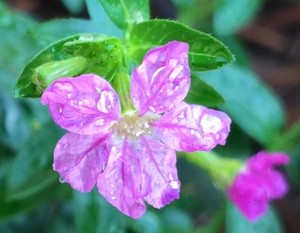After the rain.
In the picture above, a single soaked Mexican heather bloom shines and dries in the sun after an inundation of early June.
Now, it’s hot, dry and very green. The heather is basking in the heat and growing like a weed.
Summer weather is upon us – arriving right on calendar time, but late by a couple of months for this part of Texas. We have yet to experience a 100-degree-Fahrenheit (37.8-Centigrade) day. By this time in summer, we’re usually busting the century mark like popcorn popping in the hot pan.
Speaking of corn, how are things down on the farm?
I just called and Uncle Joe says most of the wheat has finally been harvested. He’s still helping to cut a neighbor’s field here and there. Joe’s wheat is in; and he says it’s looking pretty good – considering all the wet. With the wait, the individual grains are lighter and drier than normal, which keeps the bushel weight down; but there are not too many sprouts from the wet grains starting to grow on the stalks, which is good. So, “not bad,” considering.
Next up is the milo, which is also called sorghum. Joe says it’s looking pretty good — if the bugs will stay out. He may have to spray. The milo harvest should start in 2 to 3 weeks.
Corn is short this year. Standing about 6 foot, taller on the better land. Ears are formed and growing. The corn harvest should begin around the end of July or early August. Standing water has claimed a lot of land. The corn never sprouted in the flooded parts of the fields. It was drowned out. Even with the water losses, the crop should be about average.
Last and hottest is the cotton. Quite a few farmers couldn’t get into the wet fields, and their cotton never got planted. Uncle Joe was able to plant his. Cotton loves the hot, and Joe says what’s out there is looking pretty good.
Overall, considering we are now at twice the average rainfall in these parts of Texas, I’d say the crops are doing remarkably well.
We didn’t talk peaches.
This is a picture from down at the farm out the back door. The peach time-of-year is upon us. Just the other day I saw a Peach Festival advertised in a magazine for a county-seat somewhere out there in Texas. That was an alert, and I’ll start looking in the grocery for those yellowish orangish fuzzy little fruits.
Men and women have grown peaches on peach trees for over 4,000 years. Cultivation began in China, where kings and emperors favored the fruit. From there, the peach traveled to Persia, where Alexander the Great reached down form his horse for one of those luscious little globes. Smacking his lips and smitten, the conqueror turned his steed around and galloped back to Europe — the peach held high in hand. After the peach conquered that continent, Spanish explorers brought the peach to the Americas, and two more continents fell to the flavorful fruit.
It took a while, but the peach has traveled around the world, and there it remains to the joy of men and women of every nationality and culinary disposition.
Hooray the peach!
Sing with me:
Apples, peaches, pumpkin pie
Who’s not ready? Holler “I”
Let’s all play hide and seek
Apples, peaches, pumpkin pie
Who’s not ready? Holler “I”
Let’s all play hide and seek
Wow, that’s zippier than my favorite polka version by the Dujka Brothers from the Blue Bell Ice Cream lands near Brenham, Texas, but it is a delightful musical use of the peach and a well-played tune at weddings — including ours.
Summer does have its advantages — once the rains stop, the crops get going and the music starts playing.
Apples, peaches, pumpkin pie.
Grandpa Jim


